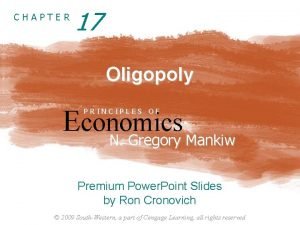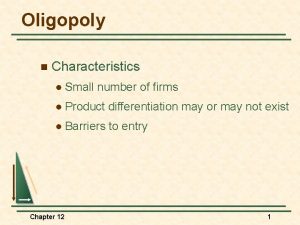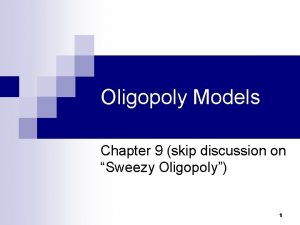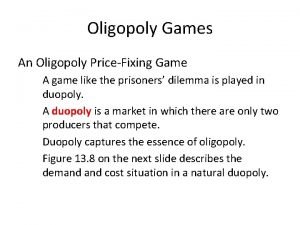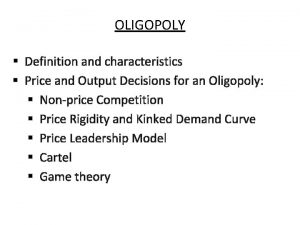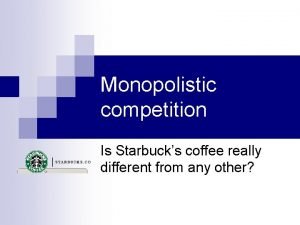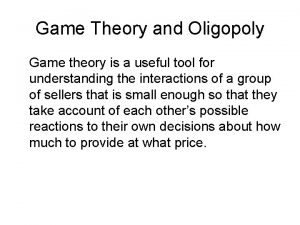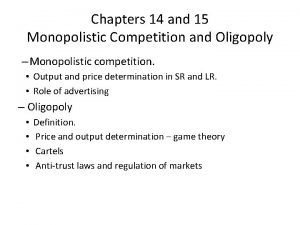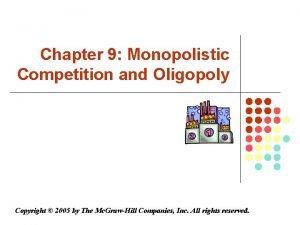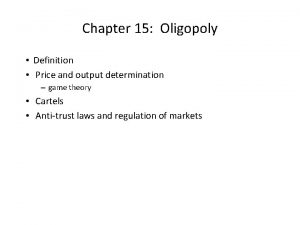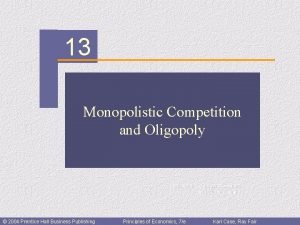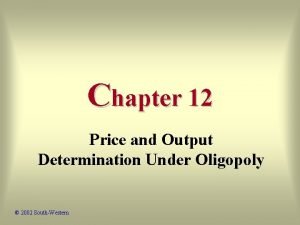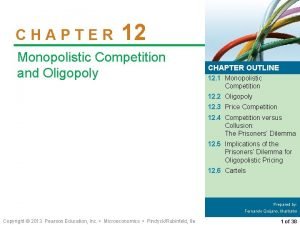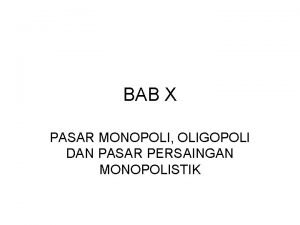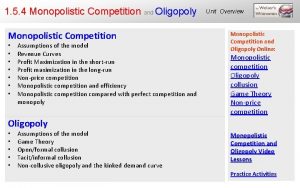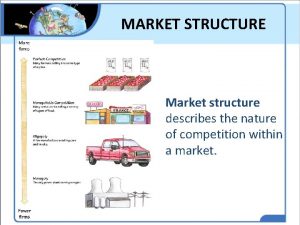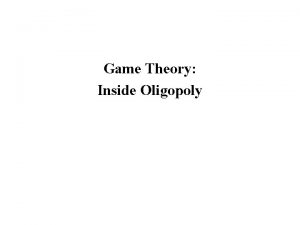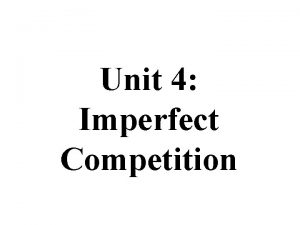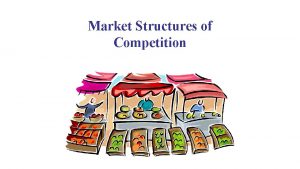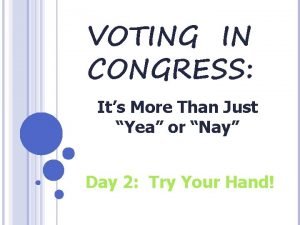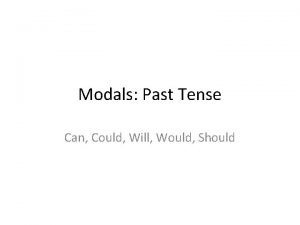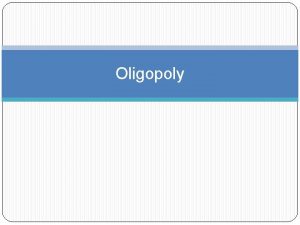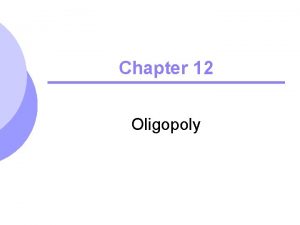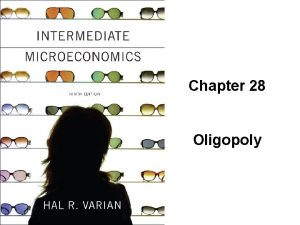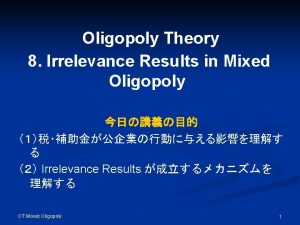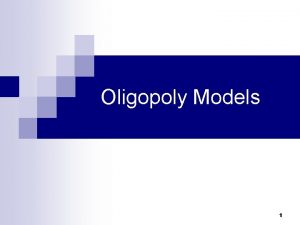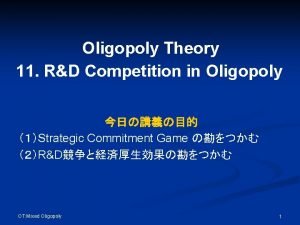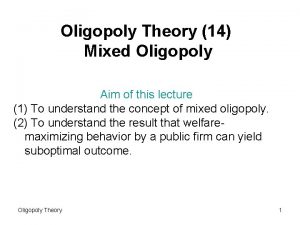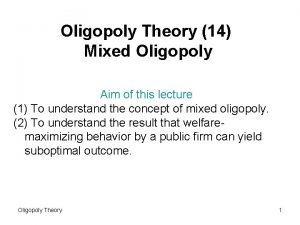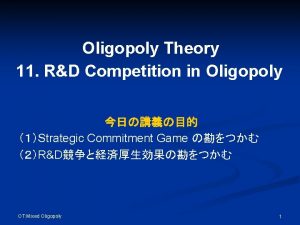Chapter 7 2 Oligopoly Cartels OLIGOPOLY We have
































































- Slides: 64

Chapter 7. 2 Oligopoly & Cartels

OLIGOPOLY • We have looked at non-cooperative oligopolies; but noted their incentive to collude. Here we want to look at various possible collusion scenarios. • Tacit collusion – price leadership: dominant firm

Dominant firm price leadership £ Leader assumes everyone else will act like a perfectly competitive firm once it sets price, by choosing output such that P=MC Dmarket O Q Division of the market between leader and followers

Dominant firm price leadership £ So Supply curve for everybody else is just their MC curve And the leader takes this MC/supply curve as given Dmarket O Q Division of the market between leader and followers

Dominant firm price leadership £ Sall other firms What is left over for the market leader at each price ? Dmarket O Q Division of the market between leader and followers

Dominant firm price leadership £ P 1 Sall other firms Above P 1 it gets nothing, below P 2 no competitors Dmarket P 2 O b Q Division of the market between leader and followers

Dominant firm price leadership £ P 1 Sall other firms Above P 1 it gets nothing, below P 2 no competitors a POF Dleader P 2 O Dmarket b Q Division of the market between leader and followers

Dominant firm price leadership £ P 1 Sall other firms What about at prices between P 1 and P 2? a POF Dleader b P 2 O Dmarket What if the price is POF ? QOF Q Division of the market between leader and followers

Dominant firm price leadership £ P 1 Sall other firms a POF Dleader P 2 O The “leftovers” represent demand curve for Dmarket the leading firm b Q Division of the market between leader and followers

Dominant firm price leadership £ P 1 Sall other firms a Dleader P 2 O The leader (of course!) maximises its profit subject to its demand curve Dmarket b Q Division of the market between leader and followers

Dominant firm price leadership £ P 1 Sall other firms To find optimal P and Q we consider, as usual, the MR, MC and AC curves. a Dmarket P 2 O b Q Division of the market between leader and followers

Dominant firm price leadership £ PL MCleader Sall other firms l Dmarket Dleader MRleader O QL Determination of price and output Q

Dominant firm price leadership £ PL MCleader l Sall other firms t Dmarket Dleader MRleader O QL QT Determination of price and output Q

Dominant firm price leadership £ PL MCleader l f Sall other firms Remember followers are a large group of smaller firms t Dmarket And QT=QL+QF Dleader MRleader O QL QF QT Determination of price and output Q

Alternative Leadership: Price leader aiming to £ maximise profits for a given market share AR = D market O Q

Price leader aiming to maximise profits for a given market share £ Assume constant market share for leader AR = D market AR = D leader =40% of Market O Q

Price leader aiming to maximise profits for a given market share £ AR = D market AR = D leader MR leader O Q

Price leader aiming to maximise profits for a given market share £ MC AR = D market AR = D leader MR leader O Q

Price leader aiming to maximise profits for a given market share £ MC PL l AR = D market AR = D leader MR leader O QL Q

Price leader aiming to maximise profits for a given market share £ MC PL l t Remainder QT-QL divided up amongst other producers AR = D market AR = D leader MR leader O QL QT Q

OLIGOPOLY • Tacit collusion – price leadership: dominant firm – price leadership: barometric ²See Sloman. Just like the case where a leading firm has a constant market share. One firm chooses price given D, MR & MC, others follow.

OLIGOPOLY • Tacit collusion – rules of thumb ²AC mark-up pricing P=(1+. 10)AC (firms somehow “agree” on a certain rate of profits). ²Benchmark Pricing £ 9. 99, £ 14, 99, £ 19. 99

OLIGOPOLY • Collusion and the law – It may be difficult to prove that firms collude, especially if collusion is tacit. – What is the difference between all firms agreeing a price and a price which is competitively set? Well, it is up to the right authorities to figure this out – typically they cannot prove anything unless it is REALLY bad.

SUMMARY We have looked at various types of imperfect competition. Lack of competition is, as a general rule, bad for consumers. Against this speaks that monopolies in some cases tend to innovate more - though this is disputed. The law typically forbids monopolistic behavior, especially collusion, but it is not an easy matter to prove anyone’s guilt.

The remaining material in this presentation was not used in lectures though it is relevant for the classwork for weeks 9 & 10. Thus part of these assignments will consist in reading section 7. 3 of Sloman. You will not be asked question about this material at the exam, however.

OLIGOPOLY • Non-collusive oligopoly: the kinked demand curve theory – assumptions of the model ² If you drop price everyone will follow ² If you raise price you are on your own

Suppose initially we have traditional diagram for firm £ But once equilibrium is established, if you raise price nobody follows you, and if you lower it everybody does MC P 1 MR O Q 1 D Q

Kinked demand for a firm under oligopoly £ So above Q 1 Demand curve is now flatter and below Q 1 it is steeper MC P 1 D O Q 1 Q

Kinked demand for a firm under oligopoly £ P 1 D O Q 1 Q

Kinked demand for a firm under oligopoly £ So now firm faces the following demand curve P 1 D O Q 1 Q

£ MR for the top part of the curve P 1 MR a O Q 1 D = AR Q

£ MR for the lower part of the curve? P 1 a D = AR b O Q 1 Q MR

£ P 1 a D = AR b O Q 1 Q MR

Kinked Demand Curve Theory • Why is this model important ? • Because it helps to explain why we tend to observe relatively stable prices in oligopolistic industries

Stable price under conditions of a kinked demand curve £ To see this lets draw in the original D, MR and MC curve here. P 1 a D = AR b O Q 1 Q MR

Stable price under conditions of a kinked demand curve £ To see this let’s draw in the original D, MR and MC curve here. P 1 a D = AR b O Q 1 Q MR

Stable price under conditions of a kinked demand curve £ To see this lets draw in the original D, MR and MC curve here. Notice the original MC lies between points a and b P 1 a D = AR b O Q 1 Q MR

Stable price under conditions of a kinked demand curve £ But what if MC changes? MC 2 P 1 MC 1 a D = AR b O Q 1 Q MR

Stable price under conditions of a kinked demand curve £ So MC can vary a lot and price won’t change MC 2 P 1 MC 1 a D = AR b O Q 1 Q MR

OLIGOPOLY • Non-collusive oligopoly: the kinked demand curve theory • Offers a reason for stable prices besides collusion • But other reasons why prices may be stable • Prices may be costly to change • Menu costs

OLIGOPOLY • Oligopoly and the public interest – advantages – disadvantages – difficulties in drawing general conclusions • Advertising and the public interest • Oligopoly and contestable markets

PRICE DISCRIMINATION • Meaning of price discrimination • Types of price discrimination – first degree

First-degree price discrimination P P 1 D O 200 Q

First-degree price discrimination P P 1 D O 200 Q

PRICE DISCRIMINATION • Meaning of price discrimination • Types of price discrimination – first degree – second degree

PRICE DISCRIMINATION • Meaning of price discrimination • Types of price discrimination – first degree – second degree – third degree

Third-degree price discrimination P P 1 D O 200 Q

Third-degree price discrimination P P 2 P 1 D O 150 200 Q

PRICE DISCRIMINATION • Meaning of price discrimination • Types of price discrimination – first degree – second degree – third degree • Conditions necessary for price discrimination to operate

PRICE DISCRIMINATION • Profit-maximising prices and output under price discrimination – first degree – third degree

Profit-maximising output under third-degree price discrimination DX O O MRX (a) Market X O

Profit-maximising output under third-degree price discrimination DY DX O MRY O O MRX (a) Market X (b) Market Y

Profit-maximising output under third-degree price discrimination DY DX O MRY O MRT O MRX (a) Market X (b) Market Y (c) Total (markets X + Y)

Profit-maximising output under third-degree price discrimination MC DY DX O MRY O MRT O MRX (a) Market X (b) Market Y (c) Total (markets X + Y)

Profit-maximising output under third-degree price discrimination MC DY DX O MRY O O MRX (a) Market X MRT (b) Market Y 3000 (c) Total (markets X + Y)

Profit-maximising output under third-degree price discrimination MC 5 DY DX O MRY O O MRX (a) Market X MRT (b) Market Y 3000 (c) Total (markets X + Y)

Profit-maximising output under third-degree price discrimination MC 5 DY DX O 1000 MRY O O MRX (a) Market X MRT (b) Market Y 3000 (c) Total (markets X + Y)

Profit-maximising output under third-degree price discrimination MC 5 DY DX O 1000 MRY O MRX (a) Market X 2000 (b) Market Y MRT O 3000 (c) Total (markets X + Y)

Profit-maximising output under third-degree price discrimination MC 9 5 DY DX O 1000 MRY O MRX (a) Market X 2000 (b) Market Y MRT O 3000 (c) Total (markets X + Y)

Profit-maximising output under third-degree price discrimination MC 9 7 5 DY DX O 1000 MRY O MRX (a) Market X 2000 (b) Market Y MRT O 3000 (c) Total (markets X + Y)

PRICE DISCRIMINATION • Profit-maximising prices and output under price discrimination – first degree – third degree • Advantages to the firm

PRICE DISCRIMINATION • Profit-maximising prices and output under price discrimination – first degree – third degree • Advantages to the firm • Price discrimination and the public interest

PRICE DISCRIMINATION • Profit-maximising prices and output under price discrimination – first degree – third degree • Advantages to the firm • Price discrimination and the public interest – advantages

PRICE DISCRIMINATION • Profit-maximising prices and output under price discrimination – first degree – third degree • Advantages to the firm • Price discrimination and the public interest – advantages – disadvantages
 Arellano
Arellano Chapter 17 oligopoly
Chapter 17 oligopoly Chapter 17 oligopoly
Chapter 17 oligopoly Chapter 7 section 3 monopolistic competition and oligopoly
Chapter 7 section 3 monopolistic competition and oligopoly Chapter 17 oligopoly
Chapter 17 oligopoly Prism with 8 faces
Prism with 8 faces Example of oligopoly market structure
Example of oligopoly market structure Oligopoly game theory matrix
Oligopoly game theory matrix Barriers to entry oligopoly
Barriers to entry oligopoly Example of sweezy oligopoly
Example of sweezy oligopoly Oligopoly game theory matrix
Oligopoly game theory matrix Monopoly vs oligopoly venn diagram
Monopoly vs oligopoly venn diagram Oligopoly definition
Oligopoly definition Starbucks oligopoly
Starbucks oligopoly Monopolistic competition graph
Monopolistic competition graph Characteristics of an oligopoly
Characteristics of an oligopoly Difference between perfect competition and monopoly market
Difference between perfect competition and monopoly market Best response functions
Best response functions Oligopoly board game
Oligopoly board game Barriers of entry for oligopoly
Barriers of entry for oligopoly Example of oligopoly market structure
Example of oligopoly market structure Price fixing definition
Price fixing definition Oligopoly game theory matrix
Oligopoly game theory matrix Price and output determination under oligopoly
Price and output determination under oligopoly Oligopoly questions
Oligopoly questions Oligopoly summary
Oligopoly summary Cartel microeconomics
Cartel microeconomics Makalah pasar oligopoli dan arsitektur perusahaan
Makalah pasar oligopoli dan arsitektur perusahaan Oligopoly demand curve
Oligopoly demand curve Market structure
Market structure Game theory inside oligopoly
Game theory inside oligopoly Non price competition in oligopoly
Non price competition in oligopoly Is uber an oligopoly
Is uber an oligopoly Oligopoly board game
Oligopoly board game Conclusion of oligopoly
Conclusion of oligopoly Monopoly vs oligopoly venn diagram
Monopoly vs oligopoly venn diagram Cornout
Cornout Oligopoly
Oligopoly Coca cola oligopoly
Coca cola oligopoly Cournot model
Cournot model Words have meaning and names have power
Words have meaning and names have power Bill a no mail on saturdays worksheet answers
Bill a no mail on saturdays worksheet answers Modal verbs suggestion
Modal verbs suggestion I have chosen you and not rejected you
I have chosen you and not rejected you I have decided i have resolved
I have decided i have resolved Ideas have consequences bad ideas have victims
Ideas have consequences bad ideas have victims Past simple
Past simple The zoo dangerous curves
The zoo dangerous curves Past tense can't
Past tense can't Have an endoskeleton and usually have spiny skin.
Have an endoskeleton and usually have spiny skin. Start with why carrots and sticks
Start with why carrots and sticks The red tent summary
The red tent summary What happens in the great gatsby chapter 8
What happens in the great gatsby chapter 8 Chapter 10 chemical reactions
Chapter 10 chemical reactions Chapter 11 chapter assessment stoichiometry answer key
Chapter 11 chapter assessment stoichiometry answer key Chapter 9 study guide chemical reactions
Chapter 9 study guide chemical reactions Chapter 7 similarity
Chapter 7 similarity Chapter 6 career readiness review
Chapter 6 career readiness review 7 ionic and metallic bonding
7 ionic and metallic bonding Chapter 9 surface water answer key
Chapter 9 surface water answer key Chapter 2 chapter assessment representing motion
Chapter 2 chapter assessment representing motion Chemistry: the central science chapter 14 answers
Chemistry: the central science chapter 14 answers Chapter 7 ionic and metallic bonding chapter answer key
Chapter 7 ionic and metallic bonding chapter answer key Chapter 4 population ecology test answer key
Chapter 4 population ecology test answer key Chapter 2 chapter assessment
Chapter 2 chapter assessment


